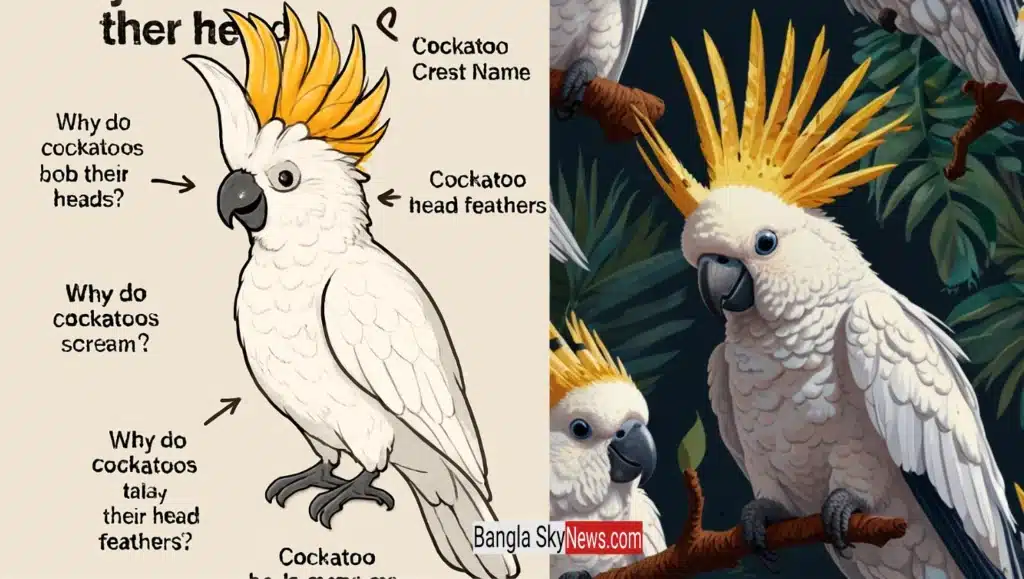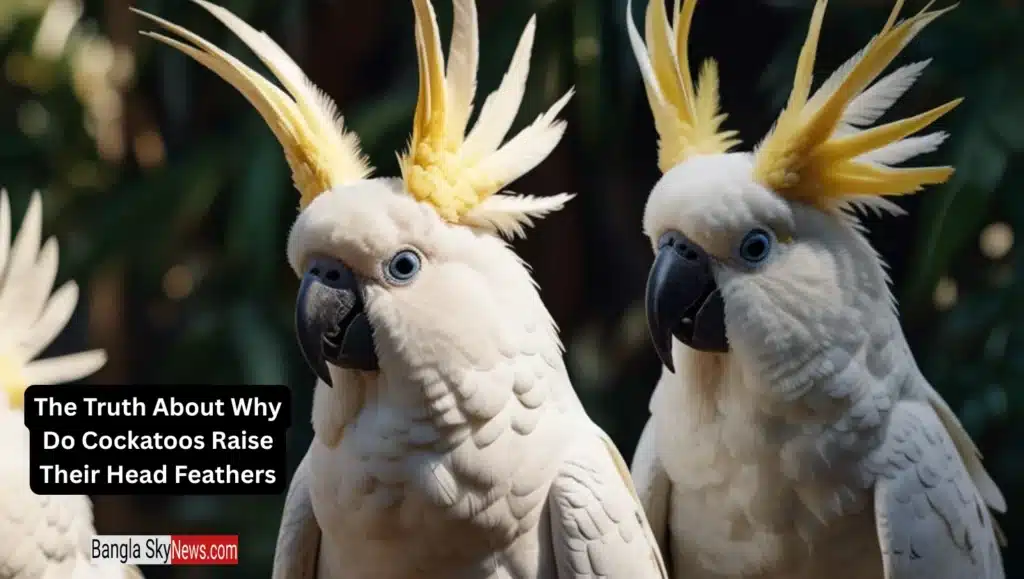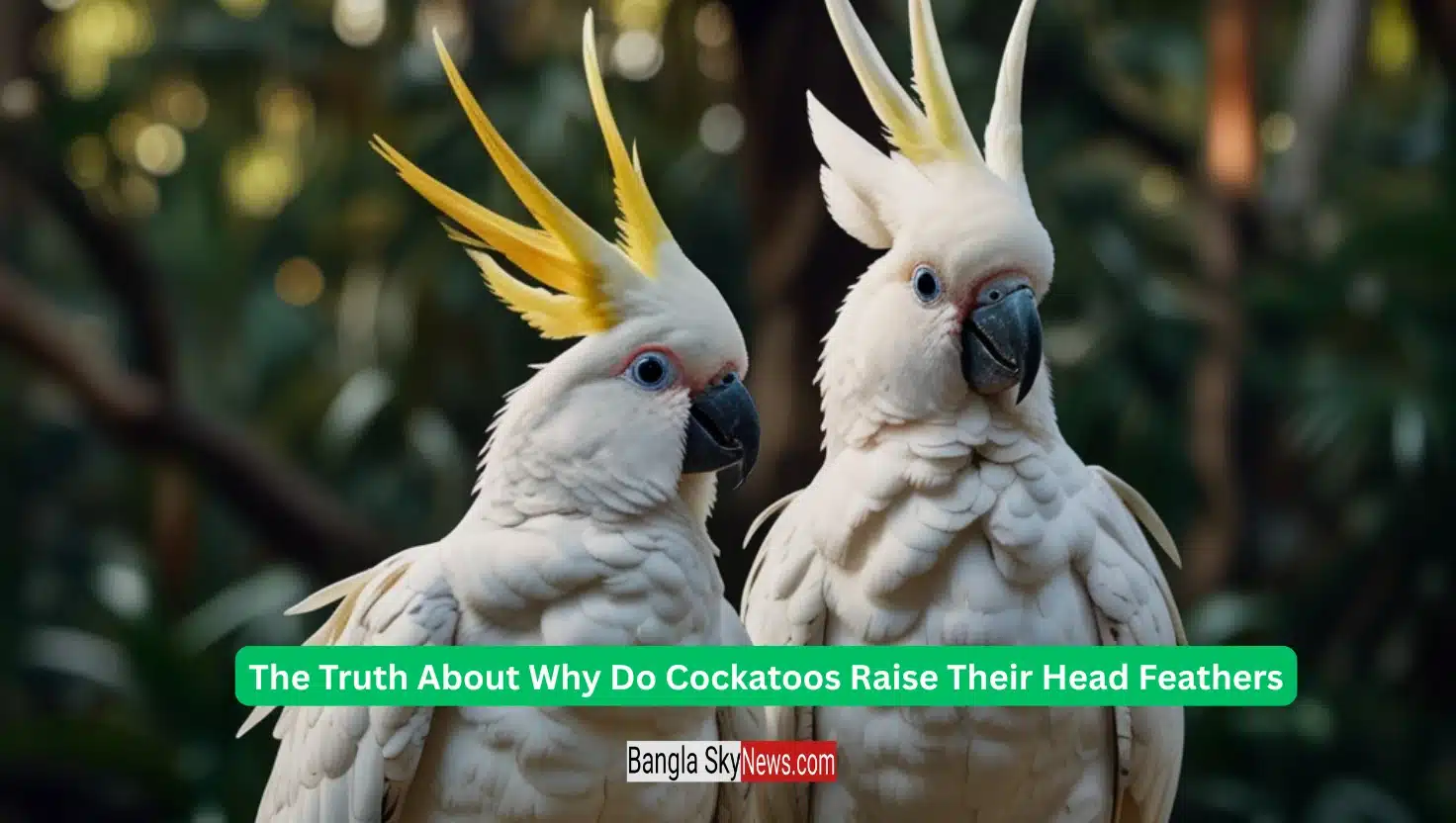Introduction
If you’ve spent time with a cockatoo, you’ve probably seen their interesting head feathers. But why do cockatoos raise their head feathers? It’s more than just a funny habit – it’s how they communicate. I’ve spent a lot of time with my cockatoo, Magnolia, and I’ve learned a lot about her behavior.
In this article, I’ll explain why they raise their head feathers, share some of my own experiences, and help you understand your cockatoo’s body language. Whether you’re new to cockatoos or you’ve had one for years, knowing why they raise their feathers will help you connect with your bird. Let’s get started!
Understanding Cockatoo Body Language
Have you ever noticed your cockatoo raising its head feathers and wondered what that means? From my time with my cockatoo, Magnolia, I’ve learned that body language is how they talk. Cockatoos don’t just squawk and flap; they show their feelings with their whole body. And the head feathers? They say a lot!
When a cockatoo raises its head feathers, it’s like they’re telling you exactly how they feel. For example, when Magnolia is excited, her feathers go up, and she gets loud and flappy—she’s ready to have fun! But when she’s relaxed, her feathers might stay flat or only rise a little. It’s like their feathers are their way of speaking. That’s why it’s so important to learn their body language. Once you start paying attention, you’ll see that even the smallest feather shift says a lot about what’s going on in their little bird brains.
So why should this matter to you as a bird lover? Understanding these signs can help you get closer to your cockatoo. If you can read their body language, you’ll know when they’re happy, when they need space, or when something is stressing them out. It’s all about strengthening that bond between you and your bird. By noticing these little cues, you can respond to their needs in a way that makes them feel safe and understood. Let’s explore what these feathers and body movements are really telling us!
Quick tip: When a cockatoo raises its head feathers, they’re usually excited or playful. These feathers are a big part of how they communicate, so learning to understand them is key to building a strong relationship.
2. Common Reasons for Raising Head Feathers
When your cockatoo raises its head feathers, it’s trying to tell you something. Here are the common reasons why they do it. I’ll share what I’ve noticed with my bird, Magnolia.
Excitement and Playfulness
One reason cockatoos raise their head feathers is excitement. When Magnolia gets excited, her feathers go up, and she flaps her wings. It’s like she’s saying, “Let’s play!” I’ve seen this when it’s treat time or when we’re playing. If your cockatoo raises its feathers in these moments, it’s a sign they’re happy and ready to have fun with you.
Confidence and Assertiveness
Cockatoos also raise their feathers to show confidence. They may spread their wings or make loud noises. Magnolia does this when she feels brave, like when there’s a new toy or person around. But be careful—this can turn into aggression. If she feels threatened, she might bite to protect herself. It’s important to read their body language and know when to give them space.
Fear or Discomfort
Cockatoos can also raise their feathers when they feel scared or uncomfortable. Magnolia does this when something unfamiliar, like a loud noise or a new person, makes her uneasy. If your cockatoo gets puffed up and alert, they’re feeling nervous. It’s best to give them space and let them calm down.
Quick Tip: Cockatoos raise their head feathers to show excitement, confidence, or fear. Understanding these signs helps you respond to their needs and emotions. Watch their body language to understand what they’re trying to tell you.
Why Do Cockatoos Raise Their Crest Feathers?

If you’ve ever seen a cockatoo raise its crest feathers, you know it’s a sight to see! But why do they do this? From my time with Magnolia, I’ve learned that raising the crest is one of the most obvious ways cockatoos show their feelings.
Crest Feathers and Communication
The crest feathers are like a special signal. When they go up, it means your cockatoo is feeling something strong, like excitement, aggression, or just wanting attention. I’ve noticed that when Magnolia sees me after being away, her crest goes up. It’s her way of saying, “I’m excited to see you!”
Excitement and Aggression
One common reason for crest-raising is excitement. When Magnolia is ready to play, her crest goes up, and she’s bouncing with joy. But not all crest-raising means joy. Cockatoos can also raise their crest when they feel confident or even aggressive. For example, if Magnolia sees something unfamiliar, like a new person, she’ll raise her crest to show she’s in charge.
Crest vs. Head Feathers
It’s important to know the difference between head feathers and the crest. Head feathers usually go up when a cockatoo feels calm, while the crest is a bigger signal. When the crest goes up, it means the bird has a strong emotion or intention. Head feathers are subtler and don’t carry as much weight.
Quick Tip: Cockatoos raise their crest feathers to show big feelings, like excitement or aggression. Understanding this helps you know how your bird feels. Whether they’re excited or protecting themselves, the crest is their way of speaking clearly!
The Spiritual Significance of Cockatoos Raising Their Head Feathers
Have you ever thought that your cockatoo’s head feathers might mean more than just body language? I’ve noticed this with my cockatoo, Magnolia. Her feathers can show more than excitement or fear—they might be showing something spiritual. I’ve come to feel that her feathers speak on a deeper level, maybe even connecting her to something beyond what we see.
Cultural and Spiritual Interpretations
In some cultures, when a cockatoo raises its head feathers, it shows they are alert or connected to something bigger than themselves. It’s like they are tuned into a higher energy. I’ve read that birds, especially cockatoos, use their body language to connect with their surroundings. They don’t just talk to us—they seem to sense something greater. When Magnolia raises her head feathers, it feels like she’s connecting to something bigger than just me or the room.
Personal Insight
For me, when Magnolia raises her feathers, it’s more than excitement. It’s like she’s sensing something deeper, something we can’t always explain. One evening, after a busy day, I came home, and the moment she saw me, her feathers went up. It felt like she was in tune with my energy, and the room suddenly felt calm. It made me stop and think, “What if she’s sensing more than I realize?”
Quick Tip: Cockatoos raise their head feathers to show more than just excitement. They may be connecting to something deeper, something spiritual. Pay attention to those moments when they feel more than playful—it could mean something important. Watch their body language; it’s a window into their inner world.
Cockatoo Body Language: Understanding the Bigger Picture

When it comes to understanding cockatoos, their body language is like a secret code that tells you how they feel. From the way they move their feathers to how they hold their body, every action has meaning. I’ve spent a lot of time with Magnolia, and over the years, I’ve learned to read her body language, which has helped us bond. It’s not just about their head feathers; it’s their entire body—their posture, movements, and little quirks that make them who they are.
The Whole Body Speaks
A cockatoo’s body language is much more than their feathers. For example, look at their stance. When Magnolia is calm, she stands with a relaxed posture, but when something catches her attention, her body becomes stiff. It’s like she’s ready for action. Her tail feathers flare, and her wings may spread when she’s feeling excited or nervous. Watching their movements tells you a lot about their mood.
Cheek Feathers and Head Bobbing
Cheek feathers are another clue. When Magnolia is happy and relaxed, her cheek feathers stay smooth. But when she’s curious or wants attention, they puff up. Then there’s head bobbing! The first time I saw Magnolia bobbing her head, I thought it was just a fun move. But now I know—it’s her way of asking for attention or showing affection. When she’s excited or happy, she bobs her head up and down, almost like she’s dancing.
Understanding Emotional States
When you pay attention to all these signs, you start to understand what your cockatoo is feeling. For example, if Magnolia is pacing and bobbing her head, she’s trying to get my attention—maybe even asking for a treat. If her feathers puff up and her wings spread, she might feel threatened or unsure. By reading these signals, I know how to respond in a way that makes her feel safe and understood. And the more you practice, the easier it gets to understand the unique language of cockatoos.
Quick Tip: Cockatoo body language is a complete picture of their emotions. Watch their posture, wings, and cheek feathers to understand their mood. Each movement gives you a glimpse into what they’re feeling, helping you connect with your bird on a deeper level.
6. Cockatoo Behavior and Communication: Why They Scream or Bob Their Heads
When you have a cockatoo, you quickly learn that they don’t just communicate with their body language—they also express themselves through sounds and movements, like screaming and head bobbing. As someone who’s spent a lot of time with Magnolia, I’ve come to understand these behaviors as a way for her to share how she’s feeling.
Screaming One of the most common things cockatoos do is scream. It’s not always as dramatic as it sounds. Cockatoos scream for many reasons, and learning to figure out why is key to understanding your bird. For Magnolia, I’ve noticed that when she screams, it’s usually because she’s feeling a little bored or wants my attention. It’s like her way of saying, “Hey, I’m here! Don’t forget about me!” Screaming can also happen when cockatoos are anxious or want to communicate with other birds. So, when your cockatoo screams, think about whether they need attention, are feeling stressed, or are simply trying to let off some energy.
Head Bobbing Then there’s head bobbing! It’s one of those behaviors that might seem odd at first, but it’s actually a really common and meaningful action. Magnolia bobs her head when she’s feeling happy or excited. It’s like her own little dance. I remember the first time I saw her bob her head, I thought it was just a fun little quirk. But now I understand—it’s her way of asking for attention, or sometimes it’s a sign of affection. If your cockatoo starts bobbing their head, it’s likely because they’re either super excited or trying to engage with you in some way.
Quick Tip: Cockatoos scream and bob their heads to express their feelings. Screaming could mean they want attention, are bored, or feeling anxious. Head bobbing, on the other hand, is often a sign of excitement or affection. The more you watch these behaviors, the easier it becomes to understand your bird’s needs and moods!
7. FAQ about The Truth About Why Do Cockatoos Raise Their Head Feathers
Why Do Cockatoos Raise Their Head Feathers?
When cockatoos raise their head feathers, it’s a sign of their emotions. They might do this to show excitement, curiosity, or confidence. From my experience with Magnolia, I know that when her feathers go up, it usually means she’s happy or ready to interact with me. So, when your cockatoo raises their feathers, it’s a clear sign that they’re feeling something strong.
Why Do Cockatoos Put Their Crown Up?
When cockatoos raise their crown feathers, it means they are showing a stronger emotion. It’s like a bold statement. For example, Magnolia raises her crest when she’s excited to see me or feeling confident. They may also do this if they feel threatened, but it’s usually a sign of a strong emotional reaction to something around them.
Are Cockatoos Aggressive When They Raise Their Feathers?
Not always! Cockatoos raise their feathers for many reasons. Aggression isn’t always one of them. For instance, when Magnolia raises her feathers during play, it just shows excitement. However, when they puff up their feathers in a defensive way, that could be a sign of aggression. It’s important to pay attention to their body language and the situation to understand what they mean.
Can Cockatoos Be Trained to Control Their Head Feathers?
You can’t train a cockatoo to control how their feathers move, but you can teach them to remain calm in certain situations. If they raise their feathers because they’re excited, you can encourage calm behavior with positive reinforcement. With patience, your cockatoo can learn to stay more composed during training.
Conclusion Why do cockatoos raise their head feathers
Understanding why cockatoos raise their head feathers helps you connect with them better. These birds use body language, especially their feathers, to express their feelings. When they raise their feathers, it can mean excitement, curiosity, or even fear. Paying attention to these signs has helped me understand Magnolia’s moods and needs more clearly.
Cockatoos, like us, express themselves in different ways. By learning to read their body language, you can respond in a way that makes them feel safe and loved. Whether you’re new to cockatoos or have had one for years, knowing how they communicate will strengthen the bond between you and your bird.
So, the next time you see your cockatoo raise its feathers, take a moment to think about what they might be telling you. It’s more than a quirky habit; it’s their way of speaking to you. The more you learn, the better you’ll understand your bird. Enjoy building a stronger relationship with your feathered friend!
Read more Related post
- Jaw-Dropping! The Dog Halloween Costume Dog Vampire is Perfect.
- Amazon Basics Dog and Puppy Pee Pads Review: A Simple Guide for Pet Owners
- The Truth About Why Do Cockatoos Raise Their Head Feathers
- The Truth About Abound Dog Food Reviews: Amazing Results!
- EHEYCIGA Memory Foam XL Dog Bed for XLarge Sized Dog Review: Ultimate Comfort!

